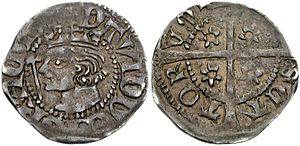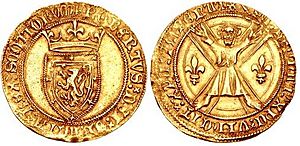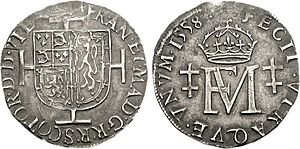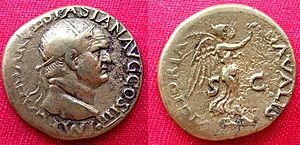Scottish coinage facts for kids
The coinage of Scotland was special and made locally from around 1124 until 1709. During this long time, many different coins were created, like the plack, bodle, bawbee, dollar, and ryal. Before Scotland had its own coins, people used money from places like Northumbria for trading. After 1709, Scotland started using coins from the Kingdom of Great Britain and later the United Kingdom.
Contents
Ancient Money: Romans and Scots (AD 71–400)
The very first coins found in Scotland came from the Roman provinces of Britain. These coins arrived through trade with the Roman Empire. Even though Hadrian's Wall was built, people in Caledonia (north of the wall) traded a lot with the Romans. Roman coins have been found all over Scotland, especially near the Antonine Wall.
Hadrian's Wall wasn't just for defense; it also helped control trade. Towns grew up south of the wall with shops and places to trade between the Romans and the people to the north. We can see groups of coins from different times, like during the Flavian and Antonine periods. For example, at Cardean Fort in Angus, Roman dupondius coins from Emperor Vespasian (AD 69–79) have been found.
Other interesting places where Roman coins turned up include North Uist, where coins from the 4th century were found. This was surprising because it was thought to be too far for trade routes. Other native sites like the Fairy Knowe broch at Buchlyvie and the broch and dun at Gargunnock in Stirlingshire also had coins.
Sometimes, large amounts of silver coins, called treasure hoards, were found buried in Roman or native pots. This might mean that Roman leaders in Britain paid large sums to people in southern Scotland. They might have even paid the northern Caledonians to keep peace. Payments to chiefs were recorded in areas like Edinburgh, Fife, Aberdeen, and the Moray Firth. Some hoards, like the one in Birnie, Moray with 200–400 silver coins, might have been offerings. Coins from Constantine II (337–342) are common, with over 20 such hoards found. By 410 AD, trade stopped as the Roman Empire left Britain.
Early Medieval Coins (500–900)
When the Roman Empire left Britain, new kingdoms appeared in the south of Scotland. One of these, Northumbria, grew and took over southern parts of what is now Scotland. Because of this, the bronze sceat coins of the Northumbrian Kings were used freely in Scotland. These coins were made from 837 to 854.
Anglo-Saxon coins were made in Northumberland, but due to busy Viking trade routes, sceat coins were also made in Frisia and Jutland (parts of Europe). Coins from this time show that Scotland traded not only with Northumberland but also with continental Europe. Norsemen (Vikings) also brought some coins. Coins from far-off places like the Byzantium and Arabic countries have been found in Scandinavia, especially Norway, which had strong connections with Scotland.
The Scottish Penny (1100–1602)
| David II (1329–1371): penny | |
|---|---|
 |
|
| King David II with sceptre | Long cross design with stars |
| 18 mm; 1.31 g; around 1351–1357. | |
The first Scottish king to make his own coins was David I (1124–1153). In 1136, he captured Carlisle, which had an English mint (a place where coins are made) and silver mines nearby. He made silver pennies that looked like the ones King Stephen made for England. David I's coins were made in Carlisle, Edinburgh, St Andrews, Roxburgh, and Berwick.
For the next 200 years, Scottish coins looked very similar to English ones. The main difference was that Scottish coins showed a side view of the king's face, while English coins showed a front view. Scottish coins also used the same designs on the back as English coins, like the Tealby, short cross, and long cross designs. They even weighed the same, so both Scottish and English coins could be used together.
| Robert III (1390–1406): gold lion | |
|---|---|
 |
|
| Royal Arms of Scotland | Saint Andrew on his cross |
David II of Scotland changed things, making Scottish coins worth less than English ones. This led England to ban the lower-quality Scottish coins in 1356. Robert III of Scotland continued to make Scottish coins worth even less. By 1392, they were worth half of English coins. He also changed the king's portrait on Scottish coins to a front-facing view, which made them easier to confuse with the more valuable English coins.
David II tried to make gold coins in Scotland, copying an English coin called the noble, but it didn't work out. However, Robert III successfully introduced the gold lion coin. This coin showed St. Andrew crucified on his X-shaped cross, which is known as a saltire.
Under James III of Scotland, Scottish coins started to look more like coins from Burgundy (a region in Europe) instead of England. He made gold rider coins and silver plack coins. James III is also remembered for the realistic portraits on his silver groat coins. He also introduced the gold unicorn coin. These changes were part of a long series of updates to Scottish coins, where their value and standards often changed. Kings would often ask people to turn in their old coins for new ones that were made to a lower standard, which made money for the king. James VI alone had eight different coin issues before he became king of both Scotland and England, which brought their coin systems closer.
At the end of the 1500s, King James VI collected all the silver coins, which weighed a huge amount (over 211 stone and 10 pounds!). These were melted down to make new coins with his image. This greatly reduced the number of older coins still around. Around this time, copper pennies were made for the first time, valued at one-twelfth of a silver penny.
Union of the Crowns (from 1603)
In 1604, a year after the Union of the Crowns (when Scotland and England shared the same king), the Council ordered Scotland to use the same coin standards as England. A new gold coin, called a Unit in Scotland or Unite in England, was worth £12 Scots or £1 sterling. Gold and fine silver coins in Scotland and England now had the same sizes and metal mixes. However, Scotland still made its own copper coins.
Both Scottish and English coins used the same royal title: "King of Great Britain, France, and Ireland." When a coin showed its value, it used a Roman numeral that could mean Scottish shillings or English pence. The designs on coins from the two kingdoms had only small differences. In Scotland, coins used the Crown of Scotland, which had a fleur-de-lis (a lily symbol) in the center between two crosses. The English crown had these symbols in opposite places. Starting in 1610, Scottish coins also used the Royal coat of arms of Scotland, which showed the Scottish lion in a more important position than the English version.
| Charles I (1625–1649) silver 60 shillings | |
|---|---|
 |
|
| Charles I with title "King of Great Britain, France, and Ireland" | Royal arms of Scotland and Scottish Crown |
| Briot’s 1637 machine-made coinage | |
In 1636, Charles I made Nicholas Briot the master of the Scottish Mint in Edinburgh. Briot, along with his Scottish son-in-law Sir John Falconer, changed how Scotland made gold and silver coins. They switched from hammered coinage (made by hand) to machine-made milled coinage. The English Civil War stopped this new coinage in 1642. During the war, Scotland made a few copper coins, but after the war, the Edinburgh mint closed. Scotland then used the regular coins of the Commonwealth of England.
Even though the Parliament of Scotland declared Charles II King in 1649, he didn't make coins in Scotland until 1664. His silver coins were based on the merk. At this time, a Scottish one merk coin was similar to an English shilling, but it was worth 13 shillings and 4 pence Scots. In 1677, Charles II introduced a copper bawbee, worth 6 pence Scots. It had a crowned thistle on the back, instead of the Britannia figure seen on English copper coins. James VII of Scotland went back to silver coins valued in shillings. Their weights were adjusted so that 13 Scottish shillings equaled 1 English shilling.
The Great Recoinage of 1707–1710
After Scotland and England joined together in 1707 to form the Kingdom of Great Britain, the Scottish silver coins (but not gold or copper) were replaced. The goal was to create a common currency for the new kingdom, as required by the Treaty of Union. This big change was managed by Sir Isaac Newton, who had already overseen a similar change in England as the head of the Mint.
Even though the exchange rate between Scottish and English money had changed over time, a 12:1 ratio (one Scottish shilling for one English penny) was used for the new coins. People were paid for the difference if their old coins were worth more. The new coins were made using Troy weights (a system of measurement), which was different from the traditional Scottish weights. Coins were made in both London and Edinburgh. Coins made in Edinburgh had a small 'E' under the king's head so they could be told apart. Under the watch of coin makers from the Tower Mint in London, a huge amount of silver (over 103,000 Troy pounds) was turned into crowns, half-crowns, shillings, and sixpences at the Edinburgh Mint. This was worth over £320,000.
This 12:1 ratio is why the Scottish Gaelic word sgillinn, which originally meant shilling, later became the word for an English penny. And bonn-a-sia, meaning "coin of six," became the word for a halfpenny. After money became decimal in 1971, sgillinn became and still is the Scottish Gaelic word for a new penny.
Because of this recoinage, foreign coins, which were often used alongside local money, stopped being legal tender (officially accepted money) on October 6, 1707. Older Scottish coins also stopped being legal tender in early 1708.
The last new coins, silver shillings and half-crowns, were delivered on October 5, 1709. These were the very last coins to be made in Scotland.
What Happened Next?
Article 16 of the Treaty of Union said that Scotland should keep its own mint.
"That, from and after the Union, the coin shall be of the same standard and value throughout the United Kingdom as now in England, and a Mint shell be continued in Scotland under the same rules as the Mint in England ; and the present officers of the Mint continued subject to such regulations and alterations as Her Majestie, her heirs or successors, or the Parliament of Great Britain shall think fit."
—Article XVI of the Acts of Union
Even though the Edinburgh Mint kept its main officials for another hundred years (until 1814), coin making stopped just two years after the Union. There were ideas to start making coins again, but it never happened. The mint itself was finally closed in 1817 and sold in 1830. Some people, like Sir Walter Scott, protested this closure, and nationalist groups continued to protest it even into the 1950s. The title 'Governor of the Mint of Scotland' was finally removed in 1971.
The change from Scottish to English coins didn't happen overnight. Scottish coins were still used in the late 1700s. The change was made a bit easier because some coin names were similar. For example, Pound Sterling is still called Punnd Sasannach (English pound) in Scottish Gaelic. Some old coin names, like bawbee, were still used in everyday talk even into the 1900s. Other names, like mark and dollar, are now more linked to foreign money for Scots today.
Some British coins later had Scottish designs on their backs. For example, the shilling from 1937 to 1970 had either English or Scottish royal arms. Its replacement, the 5p coin, had a crowned thistle from 1971 to 2008.
Today, three Scottish banks print their own banknotes (Bank of Scotland, Royal Bank of Scotland, and Clydesdale Bank), but no coins are made in Scotland. Scotland is the only part of the UK where one pound notes are still commonly used.
A List of Scottish Coins
| Mary I (1542–1567) and Francis (1558–1560): testoon | |
|---|---|
 |
|
| Crowned arms of Francis and Mary | Crowned FM with Lorraine crosses |
Just like with Scottish weights and measures, many Scottish coin names were the same as English ones, but their values were a little different. Here are some of them, with the dates and first kings who made them:
- Pistole – Gold, worth 12 pounds Scots.
- Dollar – Replaced the ryal, worth 60 Scots shillings (made by James VI).
- Ryal – Gold, first made in 1565.
- Crown or Lion – Gold (made by James I).
- Half-crown, Demi-Lion or Demys – Gold (made by James I).
- Ducat or "bonnet" – Worth 40 shillings, made in 1539 (James V).
- Mark or merk – Gold (this coin name led to the term markland for land).
- Noble – Gold, worth half a mark, made in 1357 (David II, brought back by Robert III).
- Unicorn – Gold, worth 18 shillings Scots, made 1484–85 (James III).
- Half-unicorn – Gold, worth 9 shillings Scots (James IV).
- Testoun – Silver, made in 1553. This was the first milled coinage (machine-made) in Scotland, produced in France.
- Bawbee – Made of billon (a mix of silver and base metal), worth six pence from 1537.
- Shilling.
- Groat – Silver, worth four pence, from 1357 (this coin name led to the term groatland for land).
- Half-groat – Silver, worth two pence, from 1357.
- Turner – Billon, worth two pence (James VI), later made of copper.
- Bodle – Copper, worth two pence (Charles II).
- Hardhead – Also called Lion, a billon coin used during the reigns of Mary and James VI.
- Penny – Billon, one of the earliest coins, from David I. Later made of copper; this coin name led to the term pennyland for land.
- Halfpennies – At first, these were literally half of a penny. Later, around 1280, they became coins on their own. Later made of copper.
- Farthing or quarter-penny – These were originally quarters of pennies. Like halfpennies, they became their own coins around 1280. Later made of copper.
- Plack.
Scottish Monarchs Who Made Coins
- David I (1124–1153)
- Malcolm IV (1153–1165)
- William I the Lion (1165–1214)
- Alexander II (1214–1249)
- Alexander III (1249–1286)
- John Balliol (1292–1296)
- Robert I the Bruce (1306–1329)
- David II (1329–1371)
- Robert II (1371–1390)
- Robert III (1390–1406)
- James I (1406–1437)
- James II (1437–1460)
- James III (1460–1488)
- James IV (1488–1513)
- James V (1513–1542)
- Mary I (1542–1567)
- James VI (1567–1625)
- Charles I (1625–1649)
- Charles II (1660–1685)
- James VII (1685–1688)
- William II and Mary II (1689–1694)
- William II (1694–1701)
- Anne (1701–1714, no coins minted after Union)
See also


